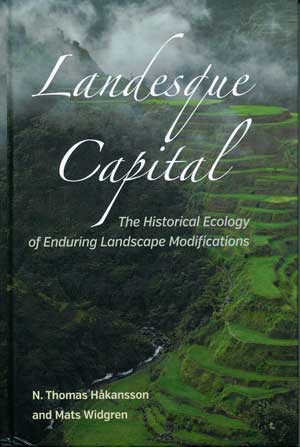In many areas of South East Asia rice terraces which are centuries old cover the mountainsides, while paddy field farming in South East Asia goes back hundreds of years. In South America recent discoveries of raised field systems which cover hundreds of square miles are rewriting our understanding of land use in that region.
These are historical examples of ‘landesque capital’, a term that has been used by political ecologists to describe an investment in productive land with an anticipated life well into the future. An effort is made when groups anticipate the labour investment will ‘pay off’ well into the future, even beyond a farmer’s lifetime, in order to substantially ‘save’ on labour and other types of inputs in future production cycles.

Domesticated landscapes and the Anthropocene concepts have revolutionized our understanding of how the world’s natural environment has been changed through human agency over millennia. While the Anthropocene concept highlights the integration of human activities over time in the natural world, scholars have not closely examined how different types of social processes are linked to different human-environmental relationships. What the concept of landesque capital adds to this research field is to incorporate the issue of labour as a crucial component of the inter-relationship between people and the environment.
Landesque capital includes the accumulated results of previous work to the land and how labour to do this work was mobilized. It also encompasses the social institutions and processes that engaged the labour that resulted in the landesque capital. Thus the building of productive and sustainable landscapes, both in the past and the present, becomes not primarily a question of indigenous knowledge or the development of new “green” techniques. Rather, it becomes a question of how labour investments and innovations to the land were made and supported by social, political, and economic institutions and contexts. This includes issues such as how the labour was organised that resulted in the landesque capital, and how the presence of that investment shaped, and shapes, social and economic processes. This question encompasses both the systematic changes that were incurred by major works, such as large irrigation canals, as well as the labour that accrues incrementally over time resulting, for example, in anthropogenic soils (defined as soil with properties which are predominantly the result of human activities).
This landesque capital approach stands in contrast to the developmentalist narrative that assumes that the cause of low productivity is found in poor soils, poor climate, poor knowledge, and poor technology. The standard prescription from the world’s development organizations is commercial inputs, education, empowerment, and markets. Within this perspective there is a strong movement to internalize natural resources within the framework of capitalist logics. Such concepts as Natural Capital and Ecosystem Services are designed to bring natural resources into a market economy by assigning prices to everything from rain forests to beaches. The proponents of this view bring it fully within the realm of capitalism, making it ever more difficult to conceptualize nature in non-capitalist ways. Because agricultural labour in many parts of the Global South is to a great extent not commodified it remains an overlooked resource.

While my explication of landesque capital has been historical, the next step to lessons for the present and the future is short. I believe development initiatives are bound to fail if they do not encompass and incorporate an understanding of what assets in the form of landesque capital smallholders already have, from the more obvious cases of terracing and irrigation, to the more subtle cases of anthropogenic soils and vegetation.
Thomas Håkansson is Adjunct Professor, Department of Anthropology at the University of Kentucky. He has done extensive field and archival research on the emergence and maintenance of irrigation and permanent agriculture in pre-colonial and colonial Kenya and Tanzania.
To find out more read N. Thomas Håkansson and Mats Widgren (eds) Landesque Capital: The Historical Ecology of Enduring Landscape Modifications, Left Coast Press, Walnut Creek, CA.